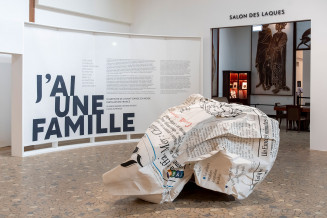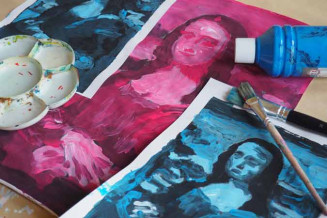
J’ai une famille
The Musée National de l’Histoire de l’Immigration is opening an Asian cycle this autumn with two new exhibitions: one on the history and diversity of migrations from East and South-East Asia, while the other, entitled J’ai une famille [I Have a Family], explores how the migratory experience marked 10 Chinese avant-garde artists.

Legende
Photo : Huang Yong Ping, Chevalier du XXIe siècle empaillé, 2019. Photo.
Archives Huang Yong Ping et Mennour, Paris.
Credit
© Huang Yong Ping © ADAGP, Paris, 2023
The exhibition
The exhibition J’ai une famille, 10 Chinese avant-garde artists living in France presents the work of contemporary Chinese artists who settled in France in the 1980s and 1990s, when China’s reform and opening-up policy and the end of the Cold War were shaping a new world order.
While their works translate their migratory paths and reactions to a changing world in very diverse ways, these artists forged a network of close-knit friendships in France, sharing similar experiences and encounters of isolation, adversity and sometimes racism. Their individual stories are all unique, but the cultural and artistic convictions that drove them into exile, their shared trajectories and the relationships they built evoke a family.
Brought together by Hou Hanru and Evelyne Jouanno, the exhibition retraces these artists’ paths over more than 30 years: Yan Pei-Ming, Ru Xiao Fan, Chen Zhen, Jiang Dahai, Huang Yong Ping, Yang Jiechang, Shen Yuan, Wang Du, Du Zhenjun and An Xiaotong (names listed in order of arrival in France).
Through their aesthetic path and diaspora living alike, these artists have contributed significantly to the transformation of French and international contemporary art scenes.
Also

Pierre Michaud, Quartier asiatique, 13e arrondissement, Paris. 1994
© Gamma Rapho
Exhibition East and south-east asian immigration since 1860
From 1860 to the present day, the exhibition retraces the collective and individual paths of East and South-East Asian migrants and their descendants, coinciding with the major upheavals of modern times.

Legende
Entrée de l'exposition « J'ai une famille »
Credit
Photo : Anne Volery © Palais de la Porte Dorée
Around the exhibition














